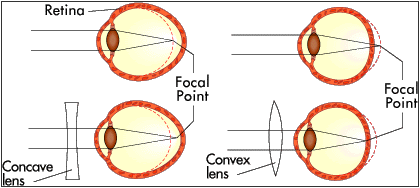
You are here: Home >> Encyclopedia of Light >> Human vision
Human vision is a complicated function and we still do not know it in full details. It has to do with the rapid interaction between eye, brain, neurons and other similar brain cells. Initially eyes receive the optic signal from a source e.g. the sun. Then the appropriate nerves transmit the signal as a kind of data to the brain. At this specific time an procedure initiates in order to interpret these data to the image we finally see. We will not analyse very much the way we see. We will only appose the basic procedure. If we can use the word "tools", we would say that the most critical - among others- for vision are the lens, the iris, the retina and the optic nerve. When we see an object an image is formed (through iris and lens) on to retina, which is consisted of millions of cells. The retina is made up of two types of cells: cones and rods.
We will not analyse very much the way we see. We will only appose the basic procedure. If we can use the word "tools", we would say that the most critical - among others- for vision are the lens, the iris, the retina and the optic nerve. When we see an object an image is formed (through iris and lens) on to retina, which is consisted of millions of cells. The retina is made up of two types of cells: cones and rods.
Cones are nerve cells that are sensitive to light, detail, and color. Cones contain three different pigments, which respond either to blue, red, or green wavelengths of light. Cones mix the color signals to produce the variety of colors we see. If a person is missing one or more of the pigments, that person is said to be color-blind and has difficulty distinguishing between certain colors, such as red from green.
Rods are designed for night vision and the detection of motion and objects. They also provide peripheral vision, but they do not see as acutely as cones. Rods are insensitive to color. When a person passes from a brightly lit place to one that is dimly illuminated, such as entering a movie theater during the day, the interior seems very dark. After some minutes this impression passes and vision becomes more distinct. In this period of adaptation to the dark the eye becomes almost entirely dependent on the rods for vision, which operate best at very low light levels. Since the rods do not distinguish color, vision in dim light is almost colorless.
 When nearsightedness (myopia) is present, a person is able to see near objects well and has difficulty seeing objects that are far away. Light rays become focused in front of the retina. This is caused by an eyeball that is too long, or a lens system that has too much power to focus. Nearsightedness is corrected with a concave lens. This lens causes the light to diverge slightly before it reaches the eye.
When nearsightedness (myopia) is present, a person is able to see near objects well and has difficulty seeing objects that are far away. Light rays become focused in front of the retina. This is caused by an eyeball that is too long, or a lens system that has too much power to focus. Nearsightedness is corrected with a concave lens. This lens causes the light to diverge slightly before it reaches the eye.
When farsightedness (hyperopia) is present, a person is able to see distant objects well and has difficulty seeing objects that are near. Light rays become focused behind the retina. This is caused by an eyeball that is too short, or by a lens system that has too little focusing power.